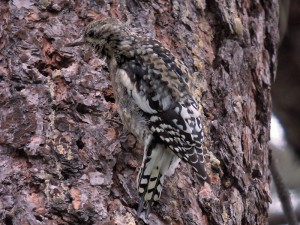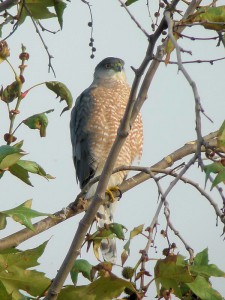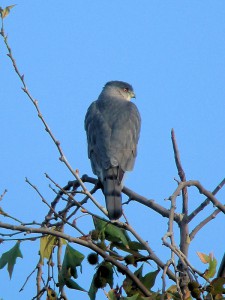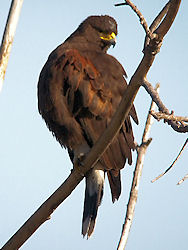 On a routine weekend in late November, we went to look at a Harris’s Hawk reported recently at San Joaquin Wildlife Sanctuary in Irvine, California. The Orange County Bird Records Committee is unlikely to accept this bird due to questionable origins. Even so, you just can’t miss a bird that cool in a location like this. We arrived at about 8:45 on a sunny Saturday morning. At least 200 Cedar Waxwings were calling from the parking lot as we set up and headed out. We walked to the end of the boardwalk, and there was the hawk, sitting regally in a bare branched tree.
On a routine weekend in late November, we went to look at a Harris’s Hawk reported recently at San Joaquin Wildlife Sanctuary in Irvine, California. The Orange County Bird Records Committee is unlikely to accept this bird due to questionable origins. Even so, you just can’t miss a bird that cool in a location like this. We arrived at about 8:45 on a sunny Saturday morning. At least 200 Cedar Waxwings were calling from the parking lot as we set up and headed out. We walked to the end of the boardwalk, and there was the hawk, sitting regally in a bare branched tree.
After taking numerous photos of him, we headed back towards the main pond area. A nice male Sharp-shinned Hawk interrupted our walk. It posed obligingly in a sycamore some 200 feet away. Next up was at least 7-8 Blue-gray Gnatcatchers, all fussing away like tiny, angry felines. As we got back to Pond D, one of the birders with us asked “Isn’t that the Vermilion Flycatcher?” He was right! It was, and a nice bright male at that.
Unexpected Blackbird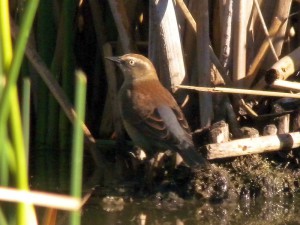
While we photographed that bird, one of us noticed what appeared to be a Brewer’s Blackbird, walking along the shore of Pond D. Upon closer examination we noticed that this bird had cinnamon plumage on the crown, nape and saddle. It also had a bright pale supercilium extending well behind the pale yellowish eye, and pale gray between the wings and on the rump. This was an apparent female Rusty Blackbird. It was a first for San Joaquin Wildlife Sanctuary and only the third for Orange County. As we observed further we noticed the handsome rufous edging to the flight feathers contrasting with the shiny black wings. The bird showed a paler brownish gray chest with faint, short vertical streaking across the chest and belly, all consistent with a female Rusty Blackbird.
Rusty Blackbird is a species of special concern in the United States at large. Its population has been in precipitous decline in recent years.
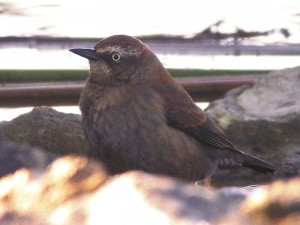 All images were taken with a Kowa TSN-884 spotting scope with 25-60x zoom eyepiece and a Nikon CoolPix P6000 camera attached using a Kowa TSN-DA-10 digiscoping adapter. The optics were mounted on a Manfrotto MT055CXPRO3 carbon fiber tripod with a MVH500AH pro fluid digiscoping head. The Rusty Blackbird photos are of the same bird. One is in direct sun at 160 feet. The other is in shade at about 40 feet. The difference in these two photos illustrates how much lighting can alter the appearance of a subject.
All images were taken with a Kowa TSN-884 spotting scope with 25-60x zoom eyepiece and a Nikon CoolPix P6000 camera attached using a Kowa TSN-DA-10 digiscoping adapter. The optics were mounted on a Manfrotto MT055CXPRO3 carbon fiber tripod with a MVH500AH pro fluid digiscoping head. The Rusty Blackbird photos are of the same bird. One is in direct sun at 160 feet. The other is in shade at about 40 feet. The difference in these two photos illustrates how much lighting can alter the appearance of a subject.

